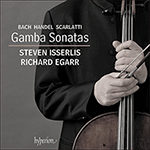Before settling in England, where he was to spend most of his life, Handel had spent time in Italy. There he met Scarlatti, and the two men became friends. A story was told about Handel attending a fancy dress party in Venice in disguise; as was his wont, he sat down at the harpsichord, and started playing. Scarlatti wandered over to listen, and was transfixed. ‘Either that is the famous Saxon’, he exclaimed, ‘or the Devil.’ It was said that in later life Scarlatti would cross himself reverently every time Handel’s name was mentioned. Like Scarlatti’s, some of Handel’s violin sonatas were for a long time thought to be intended for other instruments, several of them initially appearing as sonatas for oboe or flute. Furthermore, they were often grouped together with spurious sonatas misattributed to Handel; it is only in recent years that the confusion has been properly resolved, and this comparatively neglected side of his output has started to receive its due. The present Sonata in G minor, HWV364b, composed around 1724, was originally published as an oboe sonata. In fact, it is very much a violin sonata; but there is an authentic alternative version as well. The first page of the manuscript contains the opening bars of the violin part rewritten an octave lower in a different clef, with the words ‘per la viola da gamba’ appended in Handel’s hand—making it Handel’s only gamba sonata. Opening with a singing Andante larghetto, again far more operatic than anything in Bach’s sonatas, and concluding with a rumbustious gigue, the work is a wonderful example of a great composer writing in, and transcending, a popular style of the day.
from notes by Steven Isserlis © 2015
Avant de s’installer en Angleterre, où il allait passer la plus grande partie de sa vie, Haendel, dans sa jeunesse, vécut un certain temps en Italie. Il y rencontra Scarlatti et les deux hommes se lièrent d’amitié. On a raconté une histoire à propos de Haendel assistant à une soirée costumée à Venise; comme à son habitude, il s’assit au clavecin et commença à jouer. Scarlatti s’approcha tranquillement pour l’écouter et fut stupéfié. «Soit c’est le fameux Saxon», s’exclama-t-il, «soit c’est le diable.» On a dit que, plus tard, Scarlatti se signait très respectueusement chaque fois qu’était mentionné le nom de Haendel. Comme pour celles de Scarlatti, on a longtemps pensé que certaines sonates pour violon de Haendel étaient destinées à d’autres instruments, plusieurs d’entre elles ayant été publiées dans un premier temps comme des sonates pour hautbois ou pour flûte. En outre, elles étaient souvent regroupées avec des sonates apocryphes attribuées par erreur à Haendel; l’ambiguïté n’a été levée qu’il y a quelques années et on a commencé à rendre justice à cette part relativement négligée de son œuvre. La présente Sonate en sol mineur, HWV364b, composée vers 1724, fut publiée à l’origine comme une sonate pour hautbois. En fait, c’est une vraie sonate pour violon; mais il y a aussi une authentique version alternative. La première page du manuscrit contient les premières mesures de la partie de violon réécrites à l’octave inférieure dans une tonalité différente, avec les mots «per la viola da gamba» ajoutés de la main de Haendel—ce qui en fait la seule sonate pour viole de gambe de Haendel. Elle commence par un Andante larghetto chantant, une fois encore beaucoup plus lyrique que tout ce qu’on pourrait trouver dans les sonates de Bach, et s’achève sur une gigue sonore. Cette œuvre est un magnifique exemple d’un grand compositeur qui écrivait dans un style populaire de l’époque et le transcendait!
extrait des notes rédigées par Steven Isserlis © 2015
Français: Marie-Stella Pâris
Bevor er sich in England niederließ, wo er den Großteil seines Lebens verbringen sollte, hatte Händel in seiner Jugend mehrere Jahre in Italien verbracht. Dort hatte er Scarlatti kennengelernt und es entwickelte sich eine Freundschaft zwischen den beiden Musikern. Einer Anekdote zufolge ging Händel verkleidet zu einem Kostümfest in Venedig und setzte sich schließlich, wie er es zu tun pflegte, ans Cembalo und begann zu spielen. Scarlatti ging zu ihm, um zuzuhören und war hingerissen. „Entweder ist das der berühmte Sachse“, soll er ausgerufen haben, „oder der Teufel.“ Angeblich bekreuzigte Scarlatti sich später stets dann, wenn Händels Name ausgesprochen wurde. Auch von einigen Violinsonaten Händels wurde lange Zeit über angenommen, dass sie für andere Instrumente entstanden gewesen seien, da mehrere zunächst als Sonaten für Oboe oder Flöte erschienen waren. Zudem wurden sie oft mit zweifelhaften Sonaten, die Händel irrtümlicherweise zugeschrieben waren, zusammengefasst—erst in den letzten Jahren ist diese Verwirrung aufgeklärt worden, so dass dieser vergleichsweise vernachlässigte Teil seines Oeuvres nun allmählich entsprechend gewürdigt wird. Die hier vorliegende Sonate in g-Moll, HWV 364b, entstand um 1724 und wurde ursprünglich als Oboensonate herausgegeben. Tatsächlich trägt sie sehr violinistische Züge, doch gibt es auch eine authentische Alternativversion. Auf der ersten Seite des Manuskripts findet sich die Anmerkung „per la viola da gamba“ in Händels Handschrift zusammen mit den Anfangstakten der Violinstimme, die allerdings eine Oktave tiefer und in einem anderen Schlüssel notiert sind—womit wir es mit Händels einziger Gambensonate zu tun haben. Sie beginnt mit einem kantablen Andante larghetto, wiederum deutlich opernhafter als jegliche Passage in den Sonaten Bachs, und endet mit einer ausgelassenen Gigue—ein wunderbares Beispiel dafür, wie ein großer Komponist in einer beliebten Form seiner Zeit schreibt und über sie hinausweist.
aus dem Begleittext von Steven Isserlis © 2015
Deutsch: Viola Scheffel


 Bach, Handel & Scarlatti (D): Gamba Sonatas
Bach, Handel & Scarlatti (D): Gamba Sonatas
